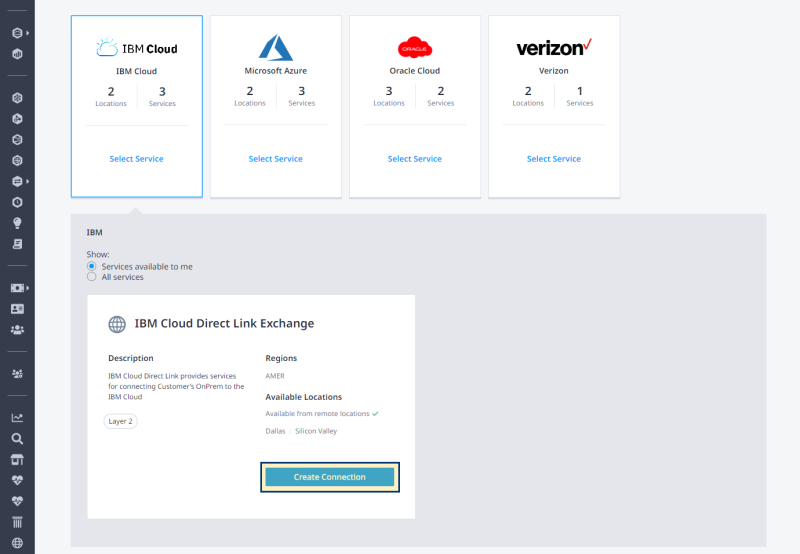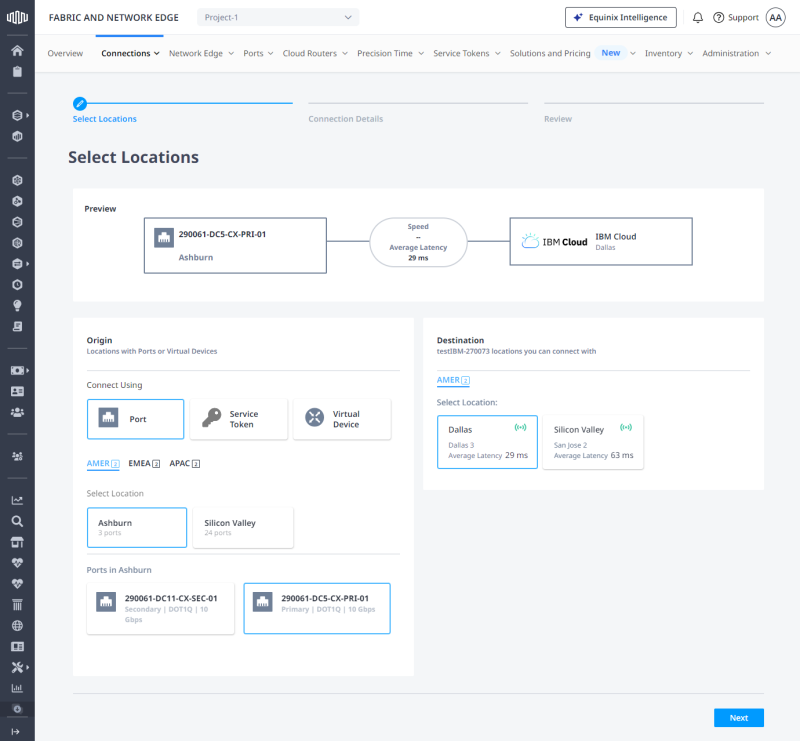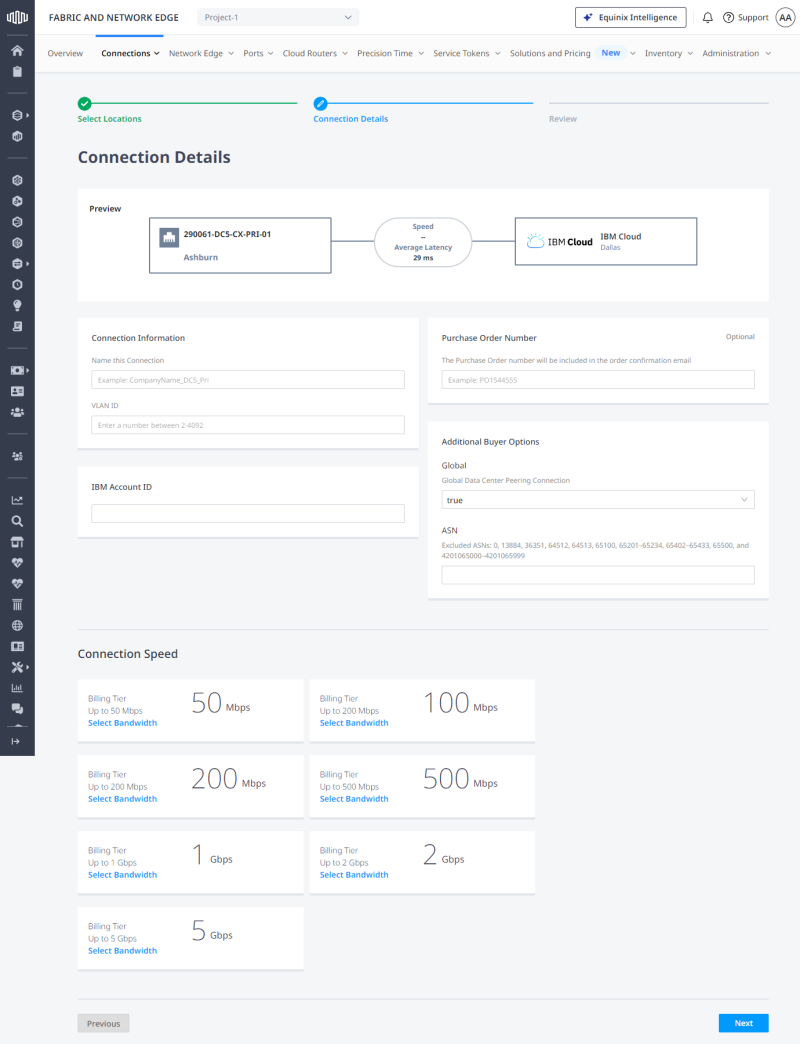IBM Cloud Direct Link on Classic (1.0)
Equinix Fabric customers can use IBM Cloud™ Direct Link on Classic to connect on-premises resources to cloud resources.
Use IBM Cloud Direct Link on Classic for:
- Private Connectivity – Establish a direct connection between a customer’s on premises data center environment to their IBM cloud environments
- Connection to IBM Cloud VPCs – Low latency, highly available connections are available such that the VPC network IP addresses are available to a customer’s on premises private network
- Access to IBM Cloud services – Access VPCs, bare metal compute, VMWare, and cloud storage
-
ASN Validation – Equinix Fabric portal users provisioning Layer 2 connections can access only valid IBM ASNs and exclude blocked ASNs and ASN ranges
-
Oversubscription Enablement – Allows oversubscription for Equinix Fabric managed ports and customer managed VLANs to efficiently manage port capacity
Local routing is included with all IBM Cloud Direct Link offerings and does not incur any overage fees. Unlimited ingress and egress traffic is provided across the Direct Link.
To reach IBM Cloud resources outside of the local market in which the Direct Link is connected (at a PoP or data center), you must add the Global Routing option. This expands your access to include all IBM Cloud data centers globally.
For more information on how to order IBM Cloud Direct Classic on Fabric, see Ordering Direct Link Exchange on Classic.
Prerequisites
-
IBM Cloud account – Set up your parameters as needed
-
Pairing Key – Copy the generated key during the account setup process
Connect to IBM Cloud through Direct Link on Classic
- Log in to Equinix Fabric.
- Click Create Connection.
- In the Frequent Connections section, locate the IBM Cloud card, and click Select Service.
-
On the IBM Cloud Direct Link Exchange card, click Create Connection.
-
Review connection procedure, then click Create a Connection to IBM Cloud Direct Link Exchange to proceed.
-
In the Origin section, select Port.
-
Select a Location, then choose a port.
-
In the Destination section, select a location, then click Next.
-
On the Connection Details page:
-
Enter a name for your connection.
-
Enter a VLAN identifier.
-
Enter an IBM Account ID.
Tip: Your IBM Cloud Account ID is the 32-character ID located in the Account section of the Account settings page.
-
Enter a Purchase Order Number
-
From the Global Data Center Peering Connection drop-down list, select:
- true, to enable global routing on Classic 1.0.
- false, to enable local routing only.
Note:
Local routing ensures access to hosts and services within the same region as the Direct Link connection.
Global routing enables access to hosts and services outside the region of the Direct Link connection. - ASN – The following three ranges of BGP ASN numbers are allowed:
1-64495
131072-4199999999
4201000000-4201064511
Note: Currently, ASN validation is available only for provisioning Layer 2 connections. If you enter an ASN number outside these ranges you will be allowed to place the order, but the connection will not show up in IBM Cloud Portal for acceptance.
-
Select a connection speed.
-
Click Next.
-
-
On the Review page, review your order information, adjust notifications settings, then click Submit Order.
Tip: You can view your newly created virtual connection for Direct Link by going to Connections. The connection will be in a pending provisioning state (Pending Provider VLAN).
Accept the connection request by navigating to the IBM Cloud Direct Link Exchange page and clicking Accept from the Action menu.
The virtual connection will display as Provisioned in the Equinix Fabric portal.
Remove the IBM Cloud Direct Link Connection
To remove the created connection, delete the resources created in both the IBM Cloud console and the Equinix Fabric portal. The connections must first be deleted in the IBM Cloud console, and then in Equinix Fabric.
Delete the IBM Cloud Direct Link Connect on the IBM Cloud Console
-
Go to the IBM Cloud console, click Interconnectivity, and select Direct Link.
-
Click the Direct Link name to display the Direct Link details.
-
Delete all the virtual connections.
-
In the Actions menu, delete the Direct Link.
Delete the Connection on the Equinix Fabric Portal
-
In the Equinix Fabric Portal, click Connections and select Connection Inventory.
-
Locate and click the connection.
-
Scroll to the bottom of the page and click Delete Connection.
Accept the Deletion on the IBM Cloud Console
-
Go to the IBM Cloud console, click Interconnectivity, and select Direct Link.
-
Click the bell icon close to the Direct Link name.
-
Confirm the deletion.




